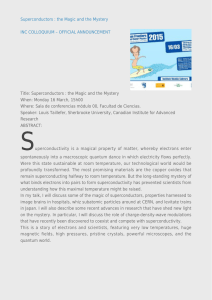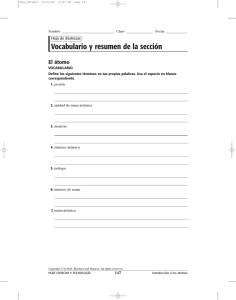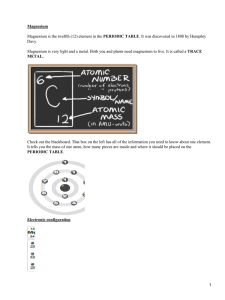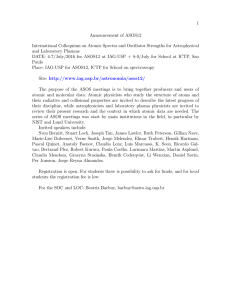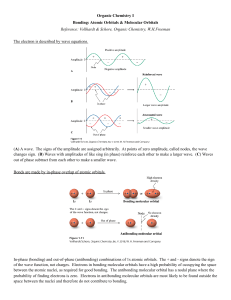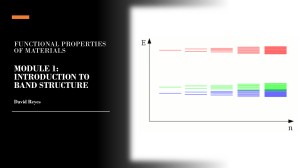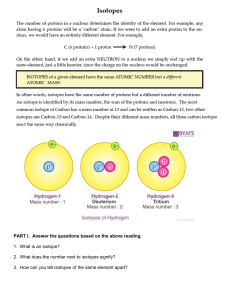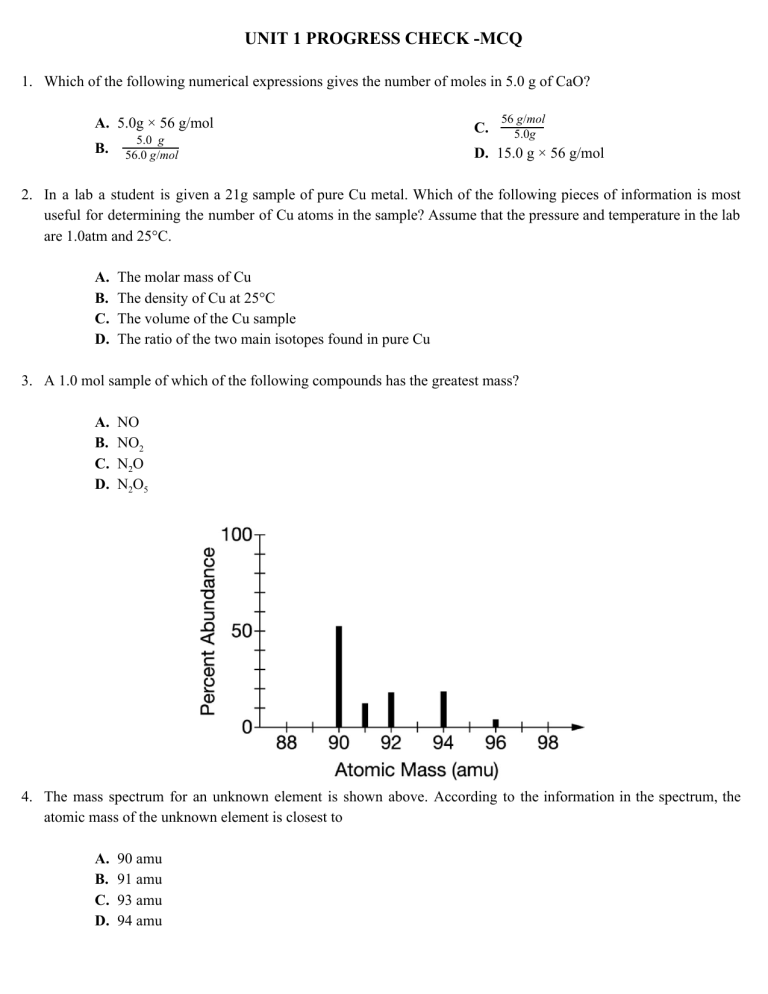
UNIT 1 PROGRESS CHECK -MCQ 1. Which of the following numerical expressions gives the number of moles in 5.0 g of CaO? A. 5.0g × 56 g/mol B. 5.0 g 56.0 g/mol C. 56 g/mol 5.0g D. 15.0 g × 56 g/mol 2. In a lab a student is given a 21g sample of pure Cu metal. Which of the following pieces of information is most useful for determining the number of Cu atoms in the sample? Assume that the pressure and temperature in the lab are 1.0atm and 25°C. A. B. C. D. The molar mass of Cu The density of Cu at 25°C The volume of the Cu sample The ratio of the two main isotopes found in pure Cu 3. A 1.0 mol sample of which of the following compounds has the greatest mass? A. B. C. D. NO NO2 N2O N2O5 4. The mass spectrum for an unknown element is shown above. According to the information in the spectrum, the atomic mass of the unknown element is closest to A. B. C. D. 90 amu 91 amu 93 amu 94 amu 5. The mass spectrum represented above is most consistent with which of the following elements? A. B. C. D. Eu Gd Tb Dy 6. Based on the mass spectrum of a pure element represented above, the average atomic mass of the element is closest to which of the following? A. B. C. D. 185.7 amu 186.0 amu 186.3 amu 186.9 amu Ba2+(aq) + SO42−(aq) → BaSO4(s) 7. A student obtains a 10.0g sample of a white powder labeled as BaCl2. After completely dissolving the powder in 50.0mL of distilled water, the student adds excess Na2SO4(s), which causes a precipitate of BaSO4(s) to form, as represented by the equation above. The student filters the BaSO4(s) , rinses it, and dries it until its mass is constant. Which of the following scientific questions could best be answered based on the results of the experiment? A. B. C. D. Is the Na2SO4(s) used in the experiment pure? Is the BaCl2(s) used in the experiment pure? What is the molar solubility of BaCl2 in water? What is the molar solubility of BaSO4 in water? 8. A student measures the mass of a sample of a metallic element, M. Then the student heats the sample in air, where it completely reacts to form the compound MO. The student measures the mass of the compound that was formed. Which of the following questions can be answered from the results of the experiment? A. B. C. D. What is the density of M? What is the molar mass of M? What is the melting point of M? What is the melting point of MO ? 9. A 42.0 g sample of compound containing only C and H was analyzed. The results showed that the sample contained 36.0 g of C and 6.0 g of H. Which of the following questions about the compound can be answered using the results of the analysis? A. B. C. D. What was the volume of the sample? What is the molar mass of the compound? What is the chemical stability of the compound? What is the empirical formula of the compound? 10. A jar labeled NaCl contains a powder. The table above contains information determined by analyzing a sample of the powder in the laboratory. What information in the table is the most helpful in determining whether the powder is pure NaCl? A. B. C. D. Mass Mass percent of Na Density Color 11. A student obtains a mixture of the chlorides of two unknown metals, X and Z. The percent by mass of X and the percent by mass of Z in the mixture is known. Which of the following additional information is most helpful in calculating the mole percent of XCl(s) and of ZCl(s) in the mixture? A. B. C. D. The number of isotopes of Cl The molar masses of X and Z The density of either XCl(s) or ZCl(s) The percent by mass of Cl in the mixture 12. A vessel contains a mixture of gases. The mass of each gas used to make the mixture is known. Which of the following information is needed to determine the mole fraction of each gas in the mixture? A. B. C. D. The molar mass of each gas The density of the gases in the vessel The total pressure of the gases in the vessel The number of atoms per molecule for each gas 1s2 2s2 2p6 3s2 3p6 13. How many unpaired electrons are in the atom represented by the electron configuration above? A. B. C. D. 0 1 2 3 14. Which of the following represents the electron configuration of an oxygen atom in the ground state? A. B. C. D. 15. Which of the following is the correct electron configuration for a ground-state atom of magnesium (atomic number 12) ? A. B. C. D. 1s2 2s2 2p8 1s2 2s2 3s2 3p6 1s2 2s2 2p6 3s2 1s2 2s2 3s4 3p4 16. The complete photoelectron spectrum of an element is given above. Which labeled peak corresponds to the 1s electrons and why? A. B. C. D. Peak X, because 1s electrons are the easiest to remove from the atom. Peak X, because 1s electrons have the strongest attractions to the nucleus. Peak Y, because electrons in the 1s sublevel are the farthest from the nucleus. Peak Y, because there are fewer electrons in an s sublevel than in a p sublevel. 17. The photoelectron spectrum for the element boron is represented above. Which of the following best explains how the spectrum is consistent with the electron shell model of the atom? A. B. C. D. The spectrum shows an odd number electrons. The spectrum shows a single electron in the 2p subshell. The spectrum shows equal numbers of electrons in the first and second electron shells. The spectrum shows three electrons with the same binding energy in the second electron shell. 18. The complete photoelectron spectrum of the element carbon is represented above. Which of the following best explains how the spectrum is consistent with the electron shell model of the atom? A. B. C. D. The spectrum shows four electrons in the inner electron shell. The spectrum shows equal numbers of electrons in the three occupied electron subshells. The spectrum shows that all the electrons in the valence shell have the same binding energy. The spectrum shows more electrons in the inner electron shell than in the outer electron shell. 19. The atomic radii of the elements in the nitrogen group in the periodic table are given in the table above. Which of the following best helps explain the trend of increasing atomic radius from N to Bi? A. B. C. D. The number of particles in the nucleus of the atom increases. The number of electrons in the outermost shell of the atom increases. The attractive force between the valence electrons and the nuclei of the atoms decreases. The repulsive force between the valence electrons and the electrons in the inner shells decreases. 20. Which of the following best helps to explain why the atomic radius of K is greater than that of Br? A. B. C. D. The first ionization energy of K is higher than that of Br. The valence electrons in K are in a higher principal energy level than those of Br. In the ground state, an atom of K has fewer unpaired electrons than an atom of Br has. The effective nuclear charge experienced by valence electrons is smaller for K than for Br. 21. Which of the following best helps explain why the first ionization energy of K is less than that of Ca? A. The electronegativity of K is greater than that of Ca. B. The atomic radius of the K atom is less than that of the Ca atom. C. The valence electron of K experiences a lower effective nuclear charge than the valence electrons of Ca. D. The nucleus of the K atom has fewer neutrons, on average, than the nucleus of the Ca atom has. 22. Which of the following best helps explain why an atom of Rb gas more easily loses an electron in a chemical reaction than an atom of Li gas? A. Rb has a higher electronegativity than Li has. B. The Rb atom has a greater number of valence electrons than the Li atom has. C. The nucleus of the Rb atom has a greater number of protons and neutrons than the nucleus of the Li atom has. D. In the Rb atom the valence electron is farther from its nucleus than the valence electron of Li is from its nucleus. 23. Rb reacts with O in a mole ratio of 2 to 1, forming the ionic compound Rb2O. Which of the following elements will react with O in a mole ratio of 2 to 1, forming an ionic compound, and why? A. B. C. D. S, because it is in the same group as O. Cs, because it is in the same group as Rb. Sr, because it is in the same period as Rb. Br, because the atomic mass of Br is similar to that of Rb. 24. What charge does Al typically have in ionic compounds, and why? A. B. C. D. +1, because in the ground state it has one unpaired electron. +2, because it has two electrons in the 2s subshell. +3, because it has three valence electrons. +4, because it is in the fourth row of the periodic table. UNIT 1 PROGRESS CHECK -FRQ For parts of the free-response question that require calculations, clearly show the method used and the steps involved in arriving at your answers. You must show your work to receive credit for your answer. Examples and equations may be included in your answers where appropriate. Question 1 Answer the following questions related to K. (a) In terms of atomic structure, explain why the atomic radius of K is larger than that of Na. (b) In terms of atomic structure, explain why the first-ionization energy K is less than that of Ca. (c) K forms the compound K2O, which is an ionic compound that is brittle. Identify another element, M, that is likely to form a brittle, ionic compound with the formula M2O. Justify your answer in terms of periodic trends. (d) The compound K2O2 also exists. A chemist can determine the mass of K in a sample of known mass that consists of either pure K2O or pure K2O2. From this information, can the chemist answer the question of which compound is in the sample? Indicate yes or no, and explain. Question 2 A sample of a pure element is analyzed using a mass spectrometer. The results are shown below. (a) How many different isotopes of the element were in the sample? (b) Describe how to use the information from the mass spectrum to determine the average atomic mass of the element. (c) Identify the element. (d) Write the ground-state electron configuration of an atom of the element that you identified in part (c).
